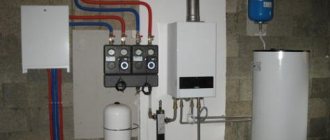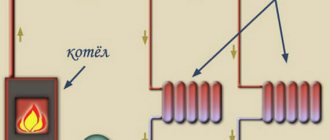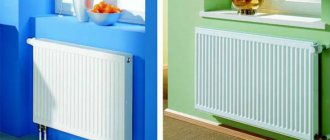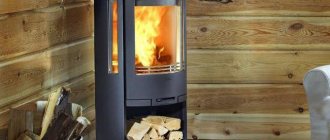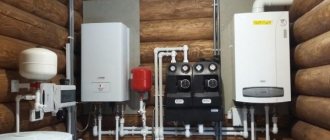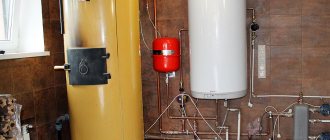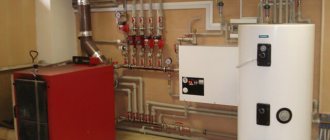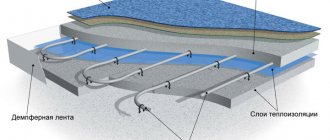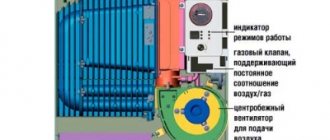05/04/2017 8200 Pechnik (Moscow) Cladding a fireplace insert requires a correct and professional approach. This is primarily due to the fact that not all materials are suitable for finishing both the hearth and the portal itself.
Equally important is compliance with the basic requirements and rules for the facing work performed. In order to become familiar with these criteria, we suggest watching the video in this article or reading the following materials in a clear and accessible presentation.
Features and types of fireplace inserts
It is important to remember that the fireplace insert will work as efficiently as possible if certain conditions are met:
- the chimney must work reliably;
- the fuel used to light the fireplace must be of high quality and not contain any harmful impurities;
- Skill in operating a fireplace is welcome.
High-quality operation of the chimney is extremely important so that the draft is continuous, and all harmful combustion products formed during the combustion of fuel are freely discharged outside. Therefore, the installation of a chimney for a fireplace must be performed impeccably. The chimney is also subject to certain requirements due to the fact that during the operation of the firebox the following features of the chimney must be taken into account:
- the height of the chimney is directly proportional to the draft forces, therefore, in order to strengthen this parameter, a longer chimney system should be equipped;
- A decrease in draft is facilitated by many small nuances that are not always immediately noticeable: various cracks and chips in the pipe body, structural elements that do not fit well together, an open fire door, etc.
If we talk about the types of fireboxes, it is customary to distinguish between two main categories: the most common open fireboxes and closed fireboxes. Each of these designs has both its advantages and disadvantages, which should be discussed in more detail. A fireplace with an open firebox is distinguished by the fact that the owners can easily see the fire burning in it, which is often quite impressive.
According to the type of construction, such a firebox is a niche in the surface of the wall, for the arrangement of which it is first necessary to strengthen the fireplace foundation. Fireplaces with a closed firebox have a higher heat output compared to units with an open firebox, since the heated air does not escape outside as much as it does in models without a door, but the aesthetic indicators are certainly higher for an open fireplace. A fireplace with a closed firebox has a number of undeniable advantages:
- the entire structure is very easy to use due to its compactness;
- installation of such equipment does not involve any difficulty;
- it is much easier to regulate the fuel combustion process in such a design than with open-type systems;
- thanks to the heat-resistant glass included in the design of such a firebox, any fire due to the emission of sparks and other unpleasant situations is excluded;
- The performance of fireplaces with a closed firebox is very high (as a rule, the efficiency is more than 80%).
It is important to remember that to equip a closed firebox you will need a fireplace with very impressive parameters, while for an open firebox a standard size fireplace will be sufficient.
In addition, all installation work, which includes both the lining of the fireplace insert and the external design, for a closed firebox is more expensive and more complex.
Rules for installing a fireplace insert
The quality of the fireplace's operation largely depends on how correctly all instructions were followed during installation. Thus, professional craftsmen recommend following the following rules:
- when determining the location where the fireplace will be located, it is important to ensure that the adjacent walls and ceiling surface can withstand high temperatures;
- the arrangement of the fireplace requires the presence of a smooth stone or ceramic base;
- as a safety measure, the base of the firebox should be equipped with a sheet of steel, the thickness of which should be more than 2 mm;
- The role of thermal insulation material will be perfectly fulfilled by basalt-based cotton wool, which must be laid between the surfaces of the floor and ceiling. This type of cotton wool is highly heat resistant (heating to 900°C will not cause any harm to it);
- one of the features of laying the firebox is the need for its gradual rounding, for which each of the subsequent bricks must be laid 6 cm closer to the beginning of the previous brick;
- the remaining mortar mixture formed after laying a row of bricks must be removed with a sponge;
- speaking about such a parameter as the thickness of the firebox walls, it should be remembered that at the side walls this parameter should be 20 cm, and at the rear edge - 10 cm;
- provided that if the fireplace is installed in a structure made of stone, then its arrangement can be done near any desired wall. But if the main structural element of the house is wood, then before installation it is necessary to build a special layer of protection. For these purposes, you can use either standard bricks or building blocks;
- the diameter of the gratings mounted in the decompression chamber must correspond to the power of the firebox used;
- in order to prevent the surface from being damaged during the operation of the fireplace, it is important to extend the chimney pipe beyond the roof by at least 1 meter;
- those sections of the chimney that cross the attic must be treated with a layer of thermal insulation;
- the joint between the fireplace insert and the chimney pipe must be completely sealed;
- in order for the air necessary for ventilation to flow to the gas outlet channel, a gap of 5 cm must be provided at the fireplace outlet area;
- the minimum height of the firebox above the floor surface is 20 cm;
- control over the air supply to the firebox will be improved by installing a special throttle-type damper mounted in the ashpit;
- Excess condensate can harm the system, so it is important to provide for the possibility of its drainage from the pipe.
Functional purpose of individual parts
Fuel is loaded into the firebox and ignited. The combustion activity and intensity of heat release are directly related to the damper - with a larger opening, maximum air enters the firebox and the wood burns better. If the design involves an open firebox, the intensity of the fire does not need to be adjusted.
To regulate the air supply you need a grate. An important point is the timely removal of ash, which collects through the grate into the ash pan. Usually it is raked out or shaken out, depending on the presence of a built-in or retractable system.
The fireplace chimney removes the accumulated combustion products to the street. To prevent gases from spreading inside the house, the chimney is often equipped with forced draft force. It is a fan. For the construction of a chimney, it is allowed to use only heat-resistant bases: brick, ceramics, heat-resistant steel.
Cladding the fireplace allows you to fit the product into the desired interior style. The portal can be stone, brick, marble. A special box is often built over a part of the pipe located within the room, which serves as an interior decoration.
There are many designs and varieties of fireplaces, but different systems differ only in details and proportions. The most famous varieties are French, German and English fireplaces.
French fireplaces are distinguished by their exquisite shapes, elegance and charm. Such a fireplace not only emphasized wealth and luxury, but was also an individual means of heating. French classic fireplaces are ideal for homes with high ceilings. Usually the design is equipped with a high and deep wall shelf. It is specially moved forward to emphasize the massiveness of the structure.
German versions are distinguished by the absence of a thermal dome. Typically, the system involves leading the pipe into the wall, and then into the chimney. A characteristic feature of modern German fireplaces is that they are equipped with a remote control. Fireplaces can be equipped with a cassette-type gas system, but there is also an electric firebox.
A classic English fireplace is usually equipped with a sloping back wall; this is necessary to reflect heat in front of the portal. In the firebox, the side mirrors serve as reflectors. It is believed that the trapezoidal shape of the structure allows heat rays to be more fully reflected into the room.
The Flemish fireplace is less common. It is an open area where fuel is ignited. The smoke from combustion is collected in a special smoke collector, with a cap hanging above the device.
Preparatory work for installing a fireplace insert
Before talking about the process of installing a fireplace insert, you should initially consider which design would be most appropriate to give preference to. Despite the prevailing stereotype regarding the old-fashioned nature of cast iron, many experts recommend choosing this material, since its reliability indicators are ideal for arranging a firebox. Having purchased the desired model, you should take care of the so-called foundation and equip a high-quality base for the fireplace.
It is best to carry out all the preparatory activities while building the house, but you can carry out the installation in an already finished structure. Here you need to remember that when installing a closed firebox, the floor under it must be equipped with a reliable coating and a heat-insulating layer must be laid.
Both fireplace inserts with a heat exchanger and any other systems require that the base be non-flammable, since high temperatures certainly carry a certain risk. The structure of the foundation for the fireplace must be strong, so it should be filled with a cement-based screed so that the final layer thickness is 15 mm. The base itself may include heat-resistant bricks or aerated concrete blocks - both of these materials withstand temperature influences and last a very long time.
Making the solution
Attention is also paid to a properly prepared solution that can withstand high temperatures and last no less than the base material. It would be optimal to prepare a clay solution, for which the required amount of clay is purchased. The solution is based on clay and mountain sand for better bonding of the material.
To calculate the required proportions, the fat content of the clay is determined. For this, 10 balls with a diameter of 1 cm are made. The amount of sand for each ball is different.
We invite you to watch the master class:
After drying, they are dropped from a meter height onto a hard surface. A ball of the correct composition will not break or become deformed. When heating with solid fuel, fireclay powder is added to the solution in an amount of about 15%.
Furnace lining process
After assembling the base, you should move on to work such as lining the fireplace insert (for more details: “How to veneer a fireplace - tips on cladding”). Panels intended for this purpose must be fixed to plasterboard sheets, maintaining a gap of about 1 - 2 cm between the cladding material and the fireplace to prevent the accumulation of excess hot air. Installing a ventilation hole in the case will also help get rid of it. Read also: “How to cladding a fireplace - finishing with stone, tiles.”
Heat supply and removal are very important aspects in the operation of any fireplace, so it is important to remember that in cast iron samples, about 30% of the heated air leaves through the base, and the rest leaves the firebox through the walls of the body. To equalize all indicators, a special pipe should be connected to the firebox, designed to remove air. For these purposes, a pipe made of PVC with a minimum cross-section of 150 mm is quite suitable. Next, the firebox must be equipped with a door on the back side of the entire structure for more convenient access to the fireplace and removal of combustion products. Upon completion of installation of the combustion chamber, it is necessary to take a responsible approach to the installation of the chimney.
Installing a chimney for a fireplace
To fix the chimney pipe to the fireplace, you must use specially designed fasteners and mechanisms, for example, a radiator equipped with a grille and pipes, the main material for which can be stainless steel 1 or 2 mm thick (it all depends on the type of steel used).
Equipping them with layers of thermal insulation will help extend the service life of these materials. Absolutely all connection elements must be located inside the pipe to avoid the negative impact of condensate that periodically occurs in the system.
Experts do not recommend making the chimney straight and advise placing its components at an angle of about 5 cm. To protect yourself from potentially uneven installation, you can place bars under the fireplace firebox to level it, which can be removed after all work is completed.
Masonry
The production of fitting brickwork is carried out “dry” without mortar. The fitting masonry is made directly on the floor close to the parallelepiped frame with gaps between the elements of 7 mm.
Upon completion, a contour of the brick cladding is outlined on the floor for further laying it with mortar. Angles must be constantly monitored horizontally and vertically.
The fireplace cornice is also first laid out “dry” from shaped material.
Work begins from the corners, constantly checking their horizontalness. Nails are driven into the side seams of the fireplace to tighten and secure the cord for laying an even row of cornices without deviations. Between the brick gap is filled with mortar.
Fireplace operating standards
In order for the fireplace system to last as long as possible, it is important not only to study photo and video materials on installation, but also to adhere to a number of requirements, namely:
- replacing wood as the main fuel with something else during the operation of the fireplace is highly not recommended, since such a desire to increase the burning rate can negatively affect its functioning;
- using water as a fire extinguisher is strictly prohibited;
- It is necessary to carry out fireplace cleaning and other maintenance at least once every two months.
To make the fireplace work better, you should always leave a layer of burnt wood about 1 cm thick on its bottom. The outer surface can be cleaned with a rag and regular soap solution. If the fireplace firebox is closed, then carbon deposits usually form on its glass from the combustion of wood, which can be easily removed with a regular glass cleaner. It is recommended to clean the inner walls with a special hard brush, which will help get rid of plaque and ash.
Adviсe
To construct a fireplace, you should not use aerated concrete or sand-lime brick, which is unstable to high temperatures. Please note that clay mortar will not stick to poor quality bricks at all or will stick extremely poorly. When laying bricks, it is recommended to moisten them with water. This is necessary for better adhesion to the solution.
The minimum thickness of the screed is 10-15 mm. Rigidity is achieved by reinforcement with metal rods or mesh. The thickness of the pedestal plaster should not exceed 1.5 cm.
There must be a hole in the fireplace for air movement. As a rule, oxygen is supplied directly from the street. To do this, prepare a hole in the wall or ceiling.
Carry out chimney installation work in accordance with fire safety regulations. For example, there are generally accepted standards for the possible deviation of a pipe from a vertical position. The angular deviation for a length of five meters should not exceed 45 degrees. The longer the chimney, the lower the deviation.
If the device is wall-mounted, consider the distance to the wall. In a house with wooden walls it should be at least 50 cm, in a house with concrete walls - at least 10 cm.
Choose the safest closed-type fireboxes for your fireplace device. A special screen made of fire-resistant glass will slow down the burning of firewood in the hearth, while the heat from the combustion of firewood will still get inside the room. Exhaust gases will be eliminated from the chamber into the chimney.
Choose protective screens for fireboxes in accordance with the main characteristics, which are based on their weight and size, as well as the provided combustion duration.
Please note that if you select the elements incorrectly and violate the rules for installation work, there may be a risk of fire. Observe the slightest details of installing a fireplace at all stages of the necessary work.
To learn how to install a fireplace in a country house yourself, watch the following video.
In order to make the interior of a private home cozy and aesthetically pleasing, one of the solutions that can help with this is installing a fireplace insert. This element will not only give any room an elegant appearance, but also, if necessary, provide additional heating to the home.
One of the difficulties that often arises during this work is the installation of a fireplace insert, since installation work in this case requires serious effort and, if possible, special construction skills. However, after studying additional photo and video materials that can help with installation, as well as detailed instructions for performing all activities, you can install the fireplace insert yourself.
